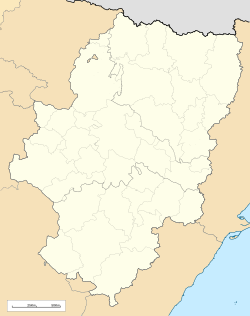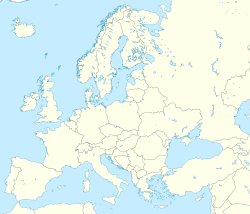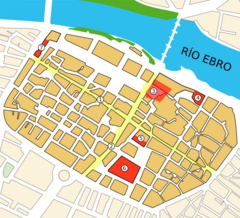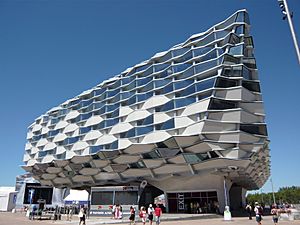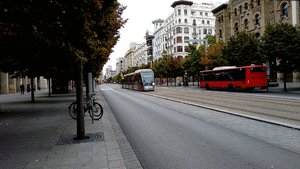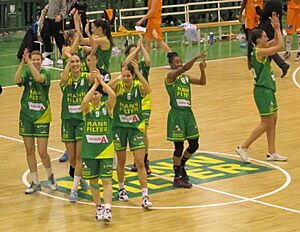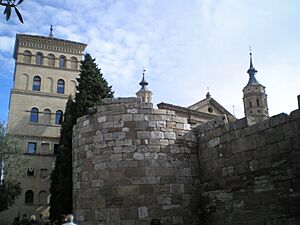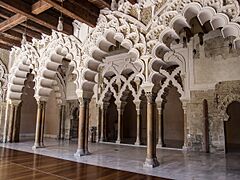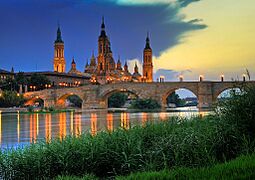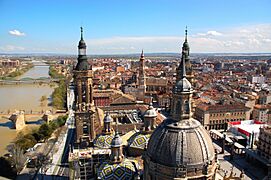Zaragoza facts for kids
Quick facts for kids
Zaragoza
Saragossa
|
|||
|---|---|---|---|
|
|||
| Nickname(s):
The Florence of Spain
|
|||
| Country | Spain | ||
| Autonomous community | Aragon | ||
| Province | Zaragoza | ||
| Comarca | Zaragoza | ||
| Districts | Centro, Casco Histórico, Delicias, Universidad, San José, Las Fuentes, La Almozara, Oliver-Valdefierro, Torrero-La Paz, Actur-Rey Fernando, El Rabal, Casablanca, Santa Isabel, Miralbueno, Sur, Distrito Rural | ||
| Government | |||
| • Type | Ayuntamiento | ||
| • Body | Ayuntamiento de Zaragoza | ||
| Area | |||
| • Total | 973.78 km2 (375.98 sq mi) | ||
| Elevation | 243 m (797 ft) | ||
| Population
(2021)
|
|||
| • Total | 675,301 | ||
| • Density | 693.484/km2 (1,796.116/sq mi) | ||
| Demonym(s) | Zaragozan (Zaragozano) (male) (Zaragozana) (female) |
||
| GDP | |||
| • Metro | €26.004 billion (2020) | ||
| Time zone | UTC+01:00 (CET) | ||
| • Summer (DST) | UTC+02:00 (CEST) | ||
| Postal codes |
50001–50022
|
||
| ISO 3166-2 | ES-Z | ||
Zaragoza is a big city in Spain. It is the capital of the autonomous community of Aragon and the province of Zaragoza. The city sits by the Ebro river, which is one of Spain's most important rivers. Two smaller rivers, the Huerva and the Gállego, also join the Ebro here. Zaragoza is located right in the middle of Aragon.
As of 2021, over 675,000 people live in Zaragoza. This makes it one of the largest cities in Spain. More than half of all people in Aragon live in this city. Zaragoza is about 208 meters (682 feet) above sea level.
In 2008, Zaragoza hosted Expo 2008, a big international event about water and how to use it wisely. The city also tried to become the European Capital of Culture in 2012.
Zaragoza is well-known for its fun traditions, tasty local food, and amazing buildings. Some famous places include the Basílica del Pilar, La Seo Cathedral, and the Aljafería Palace. These buildings, along with others, are part of the Mudéjar Architecture of Aragon. This special style of building is so important that it is a UNESCO World Heritage Site. The Fiestas del Pilar are also some of the most popular festivals in Spain.
Contents
- The Name of Zaragoza
- A Look at Zaragoza's Past
- Zaragoza's Location and Climate
- How Zaragoza is Organized
- People of Zaragoza
- Zaragoza's Economy
- Culture and Traditions
- Learning in Zaragoza
- Getting Around Zaragoza
- Sports in Zaragoza
- Amazing Places to See in Zaragoza
- Zaragoza's Sister Cities
- Famous People from Zaragoza
- Images for kids
- See also
The Name of Zaragoza
The ancient town before the Romans arrived was called Salduie. The Romans named the city Caesaraugusta. This name honored the Roman Emperor Augustus.
Over time, Caesaraugusta changed. The Arabic name Saraqusṭa was used when Muslims ruled the area. Later, it became Çaragoça in medieval times. Finally, it became the modern name, Zaragoza.
A Look at Zaragoza's Past
Zaragoza has a long and interesting history. Long ago, a tribe called the Sedetani lived in a village here.
Roman Times: Caesaraugusta
Around 25 BC, the Roman Emperor Augustus founded the city. He called it Caesaraugusta. It was a place for soldiers who had finished their service to live.
As a Roman city, it had all the important public buildings. There was a forum (a public square), baths, and a theater. It was a key center for trade and business. You can still see many Roman ruins in Zaragoza today.
People believe that Apostle James built a small church where the Cathedral-Basilica of Our Lady of the Pillar now stands.
The Church of Santa Engracia de Zaragoza was built where Saint Engratia and her friends were killed long ago. Only a small part of the church survived a war. It was rebuilt in the early 1900s and is still used today.
Zaragoza in the Middle Ages
Zaragoza did not suffer much when the Roman Empire declined. When the Goths took over in the 5th century, there was no major fighting or damage.
In the 8th century, after the Muslims took over Spain, Zaragoza became an important capital. It was the capital of the northern part of al-Andalus, which was the Muslim-ruled area.
In 1018, Zaragoza became its own independent kingdom called the Taifa of Zaragoza. It was first ruled by the Tujibid family, then by the Banu Hud family from 1039. This kingdom became very rich in culture and politics in the late 1000s. Later, the Almoravids took control in 1110.
On December 18, 1118, Alfonso I of Aragon conquered the city from the Almoravids. He made Zaragoza the capital of the Kingdom of Aragon. The city remained a special area until the early 1200s.
During the Middle Ages, Zaragoza had a Jewish community. It was a famous place where yeshivas (Jewish schools) taught not only religious studies but also philosophy.
Zaragoza in Recent History
Zaragoza faced two famous attacks during the Peninsular War against Napoleon's army. The first was from June to August 1808. The second was from December 1808 to February 1809. The city only gave up after about 50,000 defenders had died.
Trains arrived in Zaragoza on September 16, 1861. This connected the city to Barcelona. A year and a half later, on May 16, 1863, a train line to Madrid also opened.
In July 1936, a military uprising happened in Spain. Zaragoza was a strong center for workers' unions. However, the military quickly took control of the city. Many people who opposed the military fled to other areas.
During the Spanish Civil War, Zaragoza became very important for the side that took control. It produced a lot of ammunition and other goods for the war.
In 1964, Zaragoza was named a "Pole for Industrial Development." This meant the government wanted to help industries grow there. Because of this, the city's population doubled quickly. Many people moved from rural areas of Aragon to Zaragoza.
Since 1982, General Motors has had a large factory in Figueruelas, near Zaragoza. This factory makes Opel cars. Spain joining the European Union also helped Zaragoza's economy grow.
Zaragoza's Location and Climate
Where is Zaragoza?
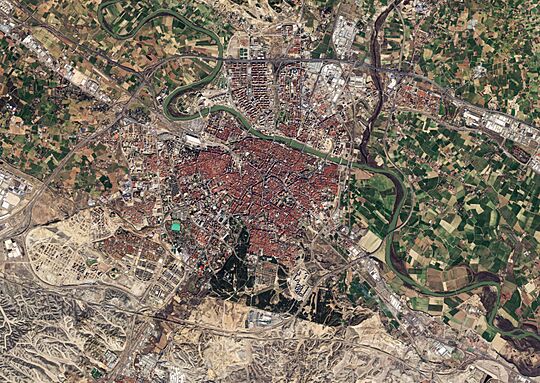
Zaragoza is in the northeast of Spain. It sits in a dry valley formed by the Ebro river. The Ebro river flows through the city. It enters the city at 205 meters (673 feet) above sea level and leaves at 180 meters (591 feet).
The city has a great location. It is roughly in the center of a hexagon formed by major Spanish cities like Bilbao, Madrid, Valencia, and Barcelona. It is also near French cities like Bordeaux and Toulouse. All these cities are about 300 kilometers (186 miles) from Zaragoza.
The municipality of Zaragoza covers 973.78 square kilometers (375.98 square miles). This makes it the ninth largest municipality in Spain.
While the river banks are mostly flat, the land around them can be rough. There are hills and steep slopes. Near the Ebro river, you can find sinkholes. These are formed when the gypsum-rich soil collapses. Some of them fill with water and become ponds.
The original Roman city was built on the right bank of the Ebro. It was also near where the Huerva river joins the Ebro. The Huerva river flows under the city for much of its path. Zaragoza is also close to where the Gállego river, a larger river from the Pyrenees mountains, joins the Ebro.
Zaragoza's Weather
Zaragoza has a semi-arid climate. This means it is quite dry. It is surrounded by mountains that block moist air from the Atlantic and Mediterranean seas. The city gets only about 322 millimeters (12.7 inches) of rain each year. It has many sunny days. The most rain falls in spring (April–May) and autumn (September–November). Summers (July–August) and winters (December–March) are drier.
Summer temperatures are hot. In winter, a cold, dry wind called the Cierzo blows from the northwest. It often freezes at night, and sometimes it snows. Fog can stay for a long time in late autumn and early winter.
How Zaragoza is Organized
Zaragoza is divided into 15 city districts and 14 rural areas.
| # | Urban district | |
|---|---|---|
| 1 | Casco Histórico | |
| 2 | Centro | |
| 3 | Delicias | |
| 4 | Universidad | |
| 5 | San José | |
| 6 | Las Fuentes | |
| 7 | La Almozara | |
| 8 | Oliver–Valdefierro | |
| 9 | Torrero | |
| 10 | El Rabal | |
| 11 | Actur–Rey Fernando | |
| 12 | Casablanca | |
| 13 | Santa Isabel | |
| 14 | Miralbueno | |
| 15 | Distrito Sur | |
People of Zaragoza
The population of Zaragoza has grown a lot over the years. Here's how it has changed:

Different Cultures in Zaragoza
Zaragoza is home to people from many different countries. In 2017, about 9.6% of the people living in Zaragoza were foreign citizens.
The largest group of foreign residents are from Romania. They make up almost 30% of all foreigners in the city. Other large groups come from Morocco and China.
| Foreign Nationals in Zaragoza in 2017 | |||||||
|---|---|---|---|---|---|---|---|
| Position | Nationality | People | |||||
| 1st | 19,064 | ||||||
| 2nd | 5,804 | ||||||
| 3rd | 4,497 | ||||||
| 4th | 3,302 | ||||||
| 5th | 2,488 | ||||||
| 6th | 2,470 | ||||||
| 7th | 2,117 | ||||||
| 8th | 1,115 | ||||||
| 9th | 1,030 | ||||||
Zaragoza's Economy
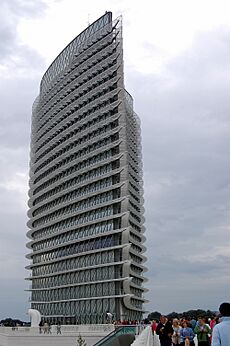
The automotive industry is a big part of Zaragoza's economy. An Opel car factory opened nearby in 1982. Other important companies include Balay, which makes home appliances, and CAF, which builds trains. There are also companies like SAICA and Torraspapel for paper, and local companies like Pikolin (mattresses), Lacasa (chocolate), and Imaginarium SA (toys).
The city's economy also got a boost from big projects. These include Expo 2008, a world's fair about water. Also, the PLAZA (Zaragoza Logistics Platform) and the PTR (Recycling Technology Park) have helped. Since 2003, the AVE high-speed train has connected Zaragoza to other major cities.
Zaragoza Airport is now a very important place for cargo flights in Spain. It is one of the busiest cargo airports in the country.
Zaragoza is also home to a Spanish Air and Space Force base. This base was once shared with the U.S. Air Force. The main Spanish Army academy, Academia General Militar, is also located here.
Culture and Traditions
Christianity has been in Zaragoza for a very long time. A legend says that St. Mary appeared to Saint James the Great in Zaragoza in the first century. She was standing on a pillar. This event is remembered by the famous Catholic church called Nuestra Señora del Pilar.
The Aragonese language is spoken by some people in Zaragoza, even though it has been declining for centuries. About 7,000 people in Zaragoza speak Aragonese today.
Fun Festivals
The yearly Fiestas del Pilar lasts for nine days. The main day is October 12. This day is also Spain's national holiday, which celebrates Spain's ties with Latin America. October 12 also marks the day Christopher Columbus arrived in the Americas.
There are many activities during the festival. These include an opening speech, fireworks over the Ebro river, marching bands, and traditional dances like jota aragonesa. You can also see a parade of gigantes y cabezudos (giants and big-headed figures), concerts, and bullfights.
Two very important events are the Ofrenda de Flores (Flower Offering) on October 12. During this event, a huge image of St. Mary is covered with flowers. On October 13, there is the Ofrenda de Frutos (Fruit Offering). Here, people from all over Spain bring their traditional foods to St. Mary. These foods are then given to soup kitchens.

Holy Week in Zaragoza is also important. It has several processions that go through the city center every day. People carry dramatic sculptures and hundreds of hooded people play drums. This festival has been recognized as a "Festival of International Tourist Interest" since 2014.
Learning in Zaragoza
The University of Zaragoza is located in the city. It is one of the oldest universities in Spain. It is a major center for research and offers many different degrees.
Zaragoza also has a special program called the MIT-Zaragoza International Logistics Program. This is a partnership between MIT (a famous university in the USA), the government of Aragon, and the University of Zaragoza.
There is also a French international school in Zaragoza called Lycée Français Molière de Saragosse.
Getting Around Zaragoza
Roads and Highways
Zaragoza is connected by motorway to major cities in central and northern Spain. These include Madrid, Barcelona, Valencia, and Bilbao. All of them are about 300 kilometers (186 miles) away.
Buses in the City
The city has a large network of buses run by Urban Buses of Zaragoza (AUZSA). There are 31 regular lines, two special routes, six shuttle buses, and seven night buses. Night buses run on Fridays, Saturdays, and holidays. Zaragoza also has intercity buses that connect it to nearby towns.
Biking Around
Zaragoza has special bicycle lanes. These help cyclists travel safely and avoid cars and pedestrians. The city also has a public bicycle-hire system called bizi zaragoza. You can rent bikes for a yearly fee.
The City Tram
The first line of the Zaragoza tram is fully working. It connects Valdespartera to Parque Goya.
Train Travel
Zaragoza is part of Spain's high-speed railway system, called AVE. This connects Zaragoza to Madrid, Lleida, Tarragona, Barcelona, and Figueres. You can reach Madrid in about 75 minutes and Barcelona in about 90 minutes.
The main train station is Zaragoza–Delicias railway station. It serves both long-distance trains and coaches. Zaragoza also has a network of local trains called Cercanías Zaragoza.
Zaragoza Airport
Zaragoza Airport is located about 10 kilometers (6 miles) from the city center. It is a major airport for cargo flights. In 2012, it handled more freight than Barcelona El Prat Airport.
The airport is also home to the Spanish Air Force's 15th Group. It was even used by NASA as a possible landing site for the Space Shuttle in emergencies.
Public Transport Habits
On average, people in Zaragoza spend about 48 minutes commuting using public transport on a weekday. About 9% of riders spend more than two hours traveling each day. People usually wait about 11 minutes for public transport. About 12% of riders wait for over 20 minutes daily. The average distance people travel in one trip is about 4.2 kilometers (2.6 miles).
Sports in Zaragoza
Football (Soccer)
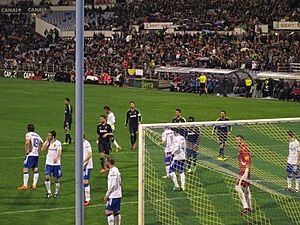
Zaragoza's main football team is Real Zaragoza. They play in the Segunda División (Second Division). The club was founded in 1932. Their home games are played at La Romareda stadium, which can hold 34,596 fans. Real Zaragoza has spent most of its history in La Liga, Spain's top league.
One of their biggest achievements was winning the UEFA Cup Winners' Cup in 1995. They have also won the Spanish National Cup, Copa del Rey, six times. A survey in 2007 showed that Real Zaragoza is the seventh most supported football club in Spain.
Zaragoza also has a second football team called CD Ebro. They play in a lower division.
Zaragoza CFF is a women's football team from Zaragoza. They play in the Segunda Federación Femenina. They used to play in the top division.
Zaragoza was one of the Spanish cities that hosted the FIFA World Cup 1982. Three matches were played at La Romareda.
Basketball
The main basketball team is Basket Zaragoza, also known as Casademont Zaragoza. They play in the Liga ACB, which is Spain's top basketball league. Their home games are at the Pabellón Principe Felipe, which holds 10,744 people.
Stadium Casablanca, also called Mann Filter, is Zaragoza's women's basketball club. They play in the Primera Division.
Futsal
The main futsal (indoor soccer) team is Dlink Zaragoza. They play in the LNFS Primera División. Their games are held at the Pabellón Siglo XXI, which has a capacity of 2,600.
Other Sports

Zaragoza's handball team, BM Aragón, plays in the Liga ASOBAL.
The Spanish Baja or Baja Aragon is a rally race held in the Aragon region. It started in 1983 and uses the Monegros desert for its scenery.
Zaragoza worked with the city of Jaca to try and host the 2014 Winter Olympics, but they were not chosen.
There are three Rugby Union teams in Zaragoza that play in the regional league:
- Ibero Club de Rugby Zaragoza
- Fénix Club de Rugby
- Club Deportivo Universitario de Rugby
A special feature built for Expo 2008 is El Canal de Aguas Bravas. This is an artificial whitewater course.
Amazing Places to See in Zaragoza
Near the Basílica del Pilar on the Ebro river, you can find several important buildings. These include the city hall and the Lonja (an old currency exchange building). There is also La Seo, a church built on top of an old mosque. Inside, you can see a large church from the 15th and 16th centuries, a Baroque tower, and a famous Museum of Tapestries. These are near the Roman ruins of the forum and city wall.
Also in the city center is the Aljafería Palace. It was built in the 11th century and has beautiful Islamic art inside. Today, it is where the Aragon parliament meets.
The churches of San Pablo, Santa María Magdalena, and San Gil Abad were built in the 14th century. Their towers might be old minarets from the 11th century. San Miguel (14th century), Santiago (San Ildefonso), and the Fecetas monastery are Baroque style with special Mudéjar ceilings from the 17th century. All these churches are Mudéjar monuments and are part of a World Heritage Site.
-
Interior of the Aljafería
Other important places to see are the grand houses and palaces from the 16th century. These include the palaces of the count of Morata (now the Audiencia), Deán, Torrero, Don Lope, count of Sástago, and count of Argillo (now the Pablo Gargallo museum). On June 14, 2008, the site of Expo 2008 opened to the public.
More Sights to Explore
- Puente de Piedra (Stone Bridge)
- San Ildefonso church
- Santa Engracia Monastery
- Fuente de la Hispanidad (Fountain of Hispanicity)
Museums in Zaragoza include:
- Museum of Fine Arts Zaragoza: This museum has paintings by early Aragonese artists, from the 15th century, and by famous artists like El Greco, Ribera, and Goya.
- Museo Goya - Colección Ibercaja - Museo Camón Aznar: Here you can see works by Rubens, Rembrandt, Van Dyck, Velazquez, Goya, Renoir, Manet, and Sorolla.
Zaragoza's Sister Cities
Zaragoza is twinned with many cities around the world. This means they have special friendly relationships.
|
|
Zaragoza also has special agreements with these cities:
Famous People from Zaragoza
Many notable people have come from Zaragoza, including:
- Abraham Abulafia (1240–1291), a founder of a special Jewish philosophy.
- Amaral (band) (established 1992), a popular music band.
- Avempace (1085–1138), a very smart person who studied many subjects.
- José Luis Gil (born 1957), a well-known actor.
- Mapi León (born 1995), a footballer for the Spain national team.
- Salma Paralluelo (born 2003), also a footballer for the Spain national team.
- St. Vincent of Saragossa (died 304), an early Christian martyr.
Images for kids
-
Assault of the French Army at Santa Engracia Monastery on 8 February 1809 during the Peninsular War. Oil on canvas, 1827.
-
View of Zaragoza (1647) by Juan Bautista Martínez del Mazo
See also
 In Spanish: Zaragoza para niños
In Spanish: Zaragoza para niños











